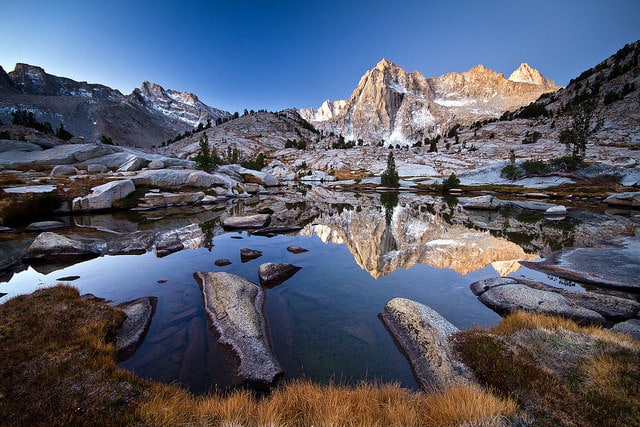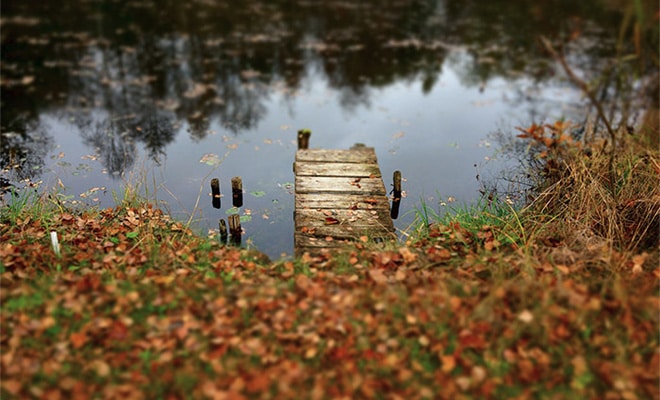One of our main objectives when taking photos is making sure the focus is sharp in the areas we want it to be, and when shooting landscapes–where a deep depth of field is generally required–sometimes it can be a little tricky to get the focus spot on in all the right places. It’s not uncommon to have both foreground and background elements that need to be in focus when taking a landscape, and photographers are often challenged in doing so.
Luckily, digital cameras have eased the pain of this to an extent, but it’s best not having to rely on our cameras to make the photographs that we want to make. And, even if you do opt to let your camera do the metering and focusing for you, it never hurts to know how to do it on your own. That’s where hyperfocal distance comes into play.
→ Related reading: 11 Steps to Tack-Sharp Landscape Photos
What Is Hyperfocal Distance?
Hyperfocal distance is a point in your composition, in which you can use to optimize your depth of field without having to compromise your f-stop setting. Once you’ve determined what your hyperfocal distance is, all you have to do is focus your camera on that point and, viola!–your depth of field will fall within an acceptable range of sharpness from one half the point of your hyperfocal distance to infinity.
Wikipedia defines it as:
“The hyperfocal distance is the closest distance at which a lens can be focused while keeping objects at infinity acceptably sharp. When the lens is focused at this distance, all objects at distances from half of the hyperfocal distance out to infinity will be acceptably sharp.”
Sounds too good to be real, doesn’t it? Luckily, the method is tried and true–it’s how many professional landscape photographers are able to capture those deep and detailed landscapes that have perfect focus from the front of the composition clear to the back.
Doing The Math
Math has never been one of my strong suits, it’s certainly not something I would say I enjoy doing, but boy am I glad I made an effort to do my best back in high school. As it turns out, all that stuff I thought I would probably never use in the real world, well, guess what? It’s time we put it use. Now, don’t worry, it isn’t too complicated to work out on your own and there’s no shame in breaking out a calculator to help with the heavy lifting.
Let’s work through the formula using the example from the graphic above just to make sure you’ve got it.
Say we’re shooting with a lens which has a focal length of 35mm and shooting at f-stop of f/11. The first thing we need to do to calculate our hyperfocal distance is multiply the focal length of our lens by itself. In this case, 35 multiplies by 35, which equals 1225. Remember that number, we’ll need it in a minute.
Next, take your f-stop and multiply it by your CoC (Circle of Confusion). We’re using f/11, so 11 multiplied by 0.03, which equals 0.33.
Now, take 1225 and divide it by 0.33. You should get: 3712.12. Add your focal length–in this instance 35mm–to that number to get your hyperfocal distance in milimeters. After rounding the decimal, you should have come up with 3747 milimeters. That’s roughly 3.75 meters or 12.3 feet.
Your hyperfocal point is 12.3 feet. That means, if you set your focal point to 12.3 feet away from the camera, everything from 6.15 feet to infinity will fall within an acceptable range of focus–giving you the maximum depth of field possible for that specific lens and aperture combination.
Feeling Circled By Confusion?
Now, if you’re wondering what in the world the circle of confusion (CoC) is–it kinda lives up to it’s name. That is, it can certainly be confusing. Take a look at this video, from The Kinectic Image, to get a better understanding:
As a rule of thumb, when using a DSLR your CoC will typically be 0.03 for a full frame body and most crop sensors will have a CoC of 0.02. If you’re using a crop sensor, you can calculate your CoC by dividing 0.03 by the crop factor of your camera’s sensor. So, if your camera has a crop factor of 1.5x, you would use: 0.03 / 1.5 = 0.02. There’s also this handy list you can refer to a math free alternative.
Make A List
If you find yourself frequently shooting with the same camera and focal length, as many landscape photographers often do, it may be in your best interest to make a little cheat sheet of all the hyperfocal distances of the different f-stops you are most likely to use. Carry the list around in your camera bag for quick reference, so you only have to the math once!
Photo license link: CC BY 2.0












Hello Tiffany, thanks for the tip.
In this calculation I have to always multiply the focal length mm by itself?
EX: If I have a 28mm I have to multiply 28 times 28?
That’s correct, Patricia! In this graphic, you can see an example of how to calculate hyper focal distance, take a look!
http://loadedlandscapes.com/wp-content/uploads/2015/11/HYPERFOCALDISTANCE.png